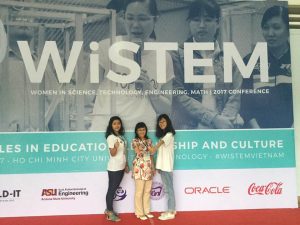WEAV PROMOTES WOMEN IN STEM
 WEAV currently awards 20% of its college scholarships to women in STEM professions. Our goal for 2018 is to expand scholarships to young women majoring in Science, Technology, Engineering and Math.
WEAV currently awards 20% of its college scholarships to women in STEM professions. Our goal for 2018 is to expand scholarships to young women majoring in Science, Technology, Engineering and Math.
Recently, WEAV was represented at the 2017 BUILD-IT Women in STEM Conference: “Gender Roles in Education, Leadership and Culture” and featured in the Outstanding Women in STEM Exhibition, sponsored by Ho Chi Minh City University of Technology.
Pictured to the right at the conference are Dr. Lan Ngoc Thi Dang and WEAV scholarship recipients Bao Ngoc Le and Than Thao Lam of Tu Duc orphanage.
INTERVIEW WITH LOIS VIETRI ON WOMEN IN STEM IN VIETNAM
In advance of the conference, Dr. Lan Dang interviewed Dr. Lois Vietri on the importance on women in stem globally and in Vietnam.
What does it mean to Lead Innovation in STEM Education and Careers? How is it unique from leading any other initiatives?
It means education and workplace innovation are required and that support needs to come from business, government, and civil society organizations especially public schools, school boards, universities, and professional educational and business organizations. Needs to be a bottom-up as well as top-down approach to innovating STEM education and careers.
Like other gender equality initiatives, increasing women’s opportunities in STEM is a basic human right and promotes the United Nations’ 2015 sustainable development goals
STEM innovation is unique because it will bring a gender perspective to the most pressing economic, social, and political challenges of the 21st century (e.g. climate change; pandemics, etc)
Challenges
- Women are scarce in scientific research and development around the world; less than one-third of stem professionals are women.
- The presences of a “leaky pipeline” that minimizes women’s opportunities in STEM: major source of the leaks is in public school education
- Women are more likely to leave technology-intensive business roles.
- Corporate culture impact’s women’s decision to leave science, engineering, and technology; on average women stay in STEM positions for ten years.
- STEM fields have fewer women on boards than other industries.
Opportunities
- UNESCO is exercising global leadership on this issue by “getting the data” on women’s career histories and workplace experience in STEM professions. The SAGA program is building a cross-national database with comparable statistics on the representation of women in STEM.
- STEM education is now on the national agenda of many countries and networks at the local, state/provincial, and national levels are promoting STEM programs to encourage girls and women to enter these fields.
- Best practices exist for building STEM programs in schools that are based on collaborative and project based learning featuring hands on student involvement to solving real world problems.
- In higher education, master teacher programs in STEM will heavily focus on building expertise in curriculum development.
- Professional associations and human resource divisions are collaborating on peer- to- peer coaching of women STEM professionals.
As education and industry seek to develop innovations in STEM education that provide opportunities to women, what will it take to make a “big impact.” What will that “big impact” look like – in your vision?
What it will take: top-down and bottom up approaches
- Change the corporate male culture in STEM-driven organizations to recognize women’s contributions by doing the following: put women on corporate boards of directors; institutionalize family friendly policies to include maternity leave and flexible leave for picking up children and caring for a sick child.
- Greater collaboration among business, civil society, and government sectors to fund programs for women in STEM
- STEM camps for girls at the primary and secondary level
- Teach girls to take responsibility for STEM education.
- Increase life-long on line and face-to-face mentoring. Women in traditionally male-dominated professionals tend to experience the imposter syndrome, that is, a crisis of confidence that they do not belong in that career and that organization. Seek positive mentoring experiences with male bosses.
How can universities connect with the private sector/industry partners for mentors and opportunities to develop women during their educational experience? What steps do you recommend for a university program that would like to build these relationships?
(e.g. Who should they reach out to? What kind of help can they ask for? etc.)
- Leverage full tuition and stipend support for women in STEM majors at the graduate and undergraduate levels
- Reach out to their donor base especially STEM alumni to raise financial support and encourage culture change in t5hei organizations
- Leverage funds from foundations like the Gates Foundation Algebra Nation
- Develop Master of Science and Ph.D. programs in STEM Education
What advice do you have for early career women seeking to build successful careers.? How can they best become key contributors and leaders in innovation in their fields?
- Take responsibility for your advancement in STEM not just in the early stage of your career but also in the middle and late stages o your career or “lean in” as argued by Sheryl Sandberg.
- Believe in your competence and capacity to make a difference in school and in work in order to overcome the imposter syndrome
- Find ways to build your confidence through professional support groups, family life, and extracurricular activities
- Develop a life-long cadre of male and female mentors in STEM and non-STEM professions
